Seeker Magazine
Skyearth Letters
by Cherie Staples
Return to the Table of Contents
Saturated with Landscape
I've been on the road from June 9 to July 3 and what a road it has been! I could have had company at least parts of the way, but my lack of enthusiasm for company was discernable by the prospective companions. I wanted to experience being by myself and I did, driving from Denver to Maine and back and seeing old friends along the way. I succeeded for the most part; I just didn't get to see all the folks I had hoped to.
June 9th: Didn't start early enough! 10:30 before I hit the road and it takes a long time to get to I-76. Once on it, the cornfields accompany me into the northeast quadrant of Colorado, the long armatures of giant sprinklers spraying umbrellas of water on the young plants. Water for corn here in the drylands seems like a waste. More on this at the end of the trip. Get off at Crook, CO, and drive a parallel road through several small (!) towns, the window down, hot air rushing in laden with meadowlark songs, ribbons of trees along the mostly-sandy South Platte River which now lies east of the road. One, Ovid, is home to a huge relic: grain bins, elevators, silos, large buildings, all part of a now-vandalized storage complex.
 Onto I-80 and into Nebraska and fields laden with hay: huge loaves artfully stacked; big round bales gleaming from the late sun shining on their green plastic wrappings. My first experience of $2/gallon gas, thankful for my 30-miles-to-the-gallon Subaru. Slept in York, about a hundred miles from the Iowa border.
Onto I-80 and into Nebraska and fields laden with hay: huge loaves artfully stacked; big round bales gleaming from the late sun shining on their green plastic wrappings. My first experience of $2/gallon gas, thankful for my 30-miles-to-the-gallon Subaru. Slept in York, about a hundred miles from the Iowa border.
June 10th: I-80 leads me eastward. Shells of a church and an old school sit beside a frontage road. An empty, worn-out barn lies hidden among the trees beside the highway, yet near to cropland. A rest area on the Salt River tells me of the Indians and the pioneers who extracted salt from its riverway; my first eastern kingbird jousts with flies; the lush herbage and thick woods at the edge of the mowed grass shows that I've reached watered country.
Forgotten
Simmering in shadows
of trees sprouted twenty years ago
still untrimmed
dark wraith of a small barn
slips by
glimpsed for five seconds
from the big highway
and yet
tilled fields
nearly reach the quiet copse
I-o-way is beautiful. Mile after mile of cornfields, terraced on the rolling hills; a beautiful gem of a little valley with a manicured farmstead; low hills sometimes topped with a fine-looking farm (and some not so fine). The hills heave a bit more in central Iowa and are less farmed, looking even more like Vermont without mountains. Then suddenly about 30 miles west of the Mississippi River, the land flattens and broad fields and farmsteads reach to the horizons far away. I skirt Davenport to the south and fly over the Mississippi's blue bridge-muddy waters, climbing out of the breaks to more flat fields.
Why do I experience this as so beautiful? Because there is not one damn housing complex in sight. No humongous over-wrought millionaires' houses. The closest is a small group of apartment/condos types being built right beside the interstate (no quiet nights there, that's for certain!). And a big upscale discount outlet mall appears beside one interchange in eastern Iowa.
830 miles today; 14 hours, listening to the hits of 1965 and singing, singing, singing. I think it is near the Illinois-Indiana border that I realize how good I feel. Oh, I have a nagging pain in the small of my back, but I feel like an outer layer of my persona has fallen away, that part of me that doesn't take chances, that 'stays home' rather than go places.
Somewhere west of Des Moines or maybe as I was getting through Des Moines, a blue-cab tractor trailer hangs out behind me. Sometimes it would get way behind as cars melded in and then would catch up again. It stays within sight until I decide to stop at a rest area, maybe 20-30 miles east, and it blurs on by. I find it comforting.
I reach the Michigan border about 7:30 and call my host for the night. The day has been beautiful, hot, and there's a thin black line in the northwest sky. We agree that I would call when I get to a town near his house and he would come out to the main drag and guide me in. About two and half hours later, I reach the town amid the fat raindrops and thunder of what is becoming a whopping thunderstorm. I find a phone and call, and then slog the last few miles, getting down to a crawl. Can't see much of the road through the buckets of rain and am leery of the wind-whipping trees. Extremely glad to see his car sitting by the road ready to show the way. My host persuades me to rest the next day, instead of continuing on, and enjoy his home overlooking a small lake.
June 12th: Across flattish eastern Michigan and the Bluewater Bridge into Ontario and along I-402 for a while. Then I strike northeast toward the lakes region of Muskoka: straight roads, flat land, farming country plus. There are farms galore in southwestern Ontario. I finally connect to I-400 well north of Toronto, heading for Port Carling and a visit with a woman whom I know from the years in Vermont.
June 13th: A day of rest. Walking with my friend along a woods-road (warblers and red-eyed vireos singing) to a path fronting one of the lakes, a path which runs along people's patios and docks and which new owners have tried to get blocked. One of the lake's longest-term owners, though, owns the last house and says not as long as he's there. Enjoy an evening visit with her friend who owns a little steam-powered paddlewheel boat and a "dippy" boat (I think it really is supposed to be D.P., as in the initials of the fellow who first manufactured them, but it feels right dippy to me when I ride in it). It's sort of a broad-beamed canoe-motorboat cross made of wood (he had restored this one) with a motor mounted in front of the second seat (there are four) and exhausted to the side of the boat. We put-put across the lake he lives on to a seasonal church for which he plays the organ and are treated to an impromptu serenade. Houses on this lake run the gamut, with some of the poshiest boathouses really outside of enough. Fine enough to raise out of the water and cart off to some mini-estate.
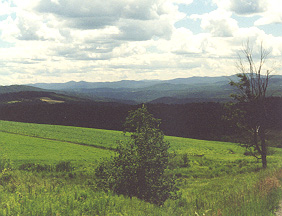 June 14th: Lonely (and quiet) provincial highways lead me downward to I-401 running east along the St. Lawrence River, although hardly within view. I don't actually see much river until the border crossing at Ogdensburg, New York, a much smaller town than Cornwall further east. Sad and abandoned farms linger along the highway across the northern part of New York state as I head toward Massena and eventually Rouse's Point Bridge to Vermont. (I mention this to my farm friends in East Montpelier, and they comment that the soils are just too poor to be farmable.) In North Hero, I talk half the night and the next morning with a good friend whose mind bends in a similar direction as mine, sharing insights and good books.
June 14th: Lonely (and quiet) provincial highways lead me downward to I-401 running east along the St. Lawrence River, although hardly within view. I don't actually see much river until the border crossing at Ogdensburg, New York, a much smaller town than Cornwall further east. Sad and abandoned farms linger along the highway across the northern part of New York state as I head toward Massena and eventually Rouse's Point Bridge to Vermont. (I mention this to my farm friends in East Montpelier, and they comment that the soils are just too poor to be farmable.) In North Hero, I talk half the night and the next morning with a good friend whose mind bends in a similar direction as mine, sharing insights and good books.
June 15th: East Montpelier — "home." I am on the trail road to the back fields of Fairmont Farm. I get no further than 200 feet along the trail when a hermit thrush sings. This is what I've come for. A little further and a veery spirals down the scale, and further, another thrush. The air is mostly still — a red-eyed vireo is doing its everlasting chatter. It is green, so green, and the smell of earth is richly aromatic of moistness and leaf soil. Warblers are tset-zeeing.
How to explain the quiet burst of peacefulness and shivery love that I feel, gazing along this high-roofed tunnel of maples and beeches, tall grey trunks holding up the roof. Sunshafts limn through the woods, creating mosaics of light and shadow. The chickadees are still singing phoe-bee, and the yellowthroat sparkles the air with its wichity song. Saucer-size maple leaves glow with the sunlight shining through them. Deep memories.
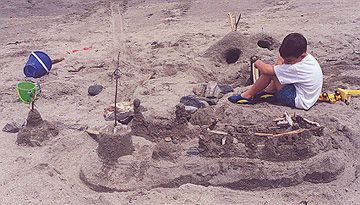
June 16th: A day spent talking, talking, talking, catching up with news of my old church, old friends, old workplace, and then giving my son David a ride to Worcester, Massachusetts, and finally, back to my sister's in New Hampshire.
June 17th through 24th: Finally, a week at the beach with three sisters and a brother and a great-niece. About nine years ago, one sister decided to treat my daughter and her friend to a week at York, Maine. Been coming ever since. The third year she found the house that we stay in, and it feels like my "other" home when I walk in the door. Hardly five minutes walk to beach-combing, sand-castle building, wave walking, and …the Goldenrod, purveyor of saltwater taffy and some of the finest chocolate around. She and I like the peacefulness, and we tend not to go many places. Not so with another sister and brother who come and then are off beach-combing at other beaches up and down the coast. I get the queen-size bed in the southeast room, and it always feels so good. Making sure there's a puzzle in the building...get through only two of them because the first one is tough. (The first year we were there, we discovered half a dozen puzzles with their pieces mixed up. We successfully unmixed them by building each one.) Introduce my teen-aged niece to sand-building and sculpting.
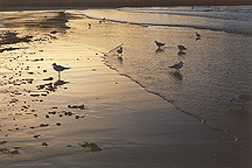 We walk the path through the Rachel Carson National Wildlife Refuge, and I remember the wonderful performance at the conference in May by a woman who became "Rachel" during the last three years of her life, in the aftermath of writing Silent Spring and the foreknowledge of her death from cancer. At Parsons Beach, I am entranced by the way the sun creates a glittering sheen on the just-wet sand as the waves retreat. At Short Sands, the gulls walk the wet sands and, against the dusk, float up and down the beach.
We walk the path through the Rachel Carson National Wildlife Refuge, and I remember the wonderful performance at the conference in May by a woman who became "Rachel" during the last three years of her life, in the aftermath of writing Silent Spring and the foreknowledge of her death from cancer. At Parsons Beach, I am entranced by the way the sun creates a glittering sheen on the just-wet sand as the waves retreat. At Short Sands, the gulls walk the wet sands and, against the dusk, float up and down the beach.
June 25th – June 30th: Back on the road this week, short trips visiting more family and more folks from where I used to work, and DENISE RUIZ…Ellenodale…the mother of Seeker Magazine. I had not met Denise before this, although we could certainly chat up a storm on the phone. I stay overnight at her home (and Mike's), and talk….and talk….and talk and hug in person, not through the ether. Got a kernel for an essay re: feminism and humanism.
July 1st – 3rd : Finally, have to head west, driving from Hopewell, NJ, across Pennsylvania, Ohio, Indiana, Illinois, Missouri, Kansas, Colorado. Three days solid driving a car with no cruise control leaves my right hip sore, 'cause I can't ever bend my knee. Does that make sense?
In Pennsylvania, I jog off the Turnpike to run through Lancaster County. Crest one ridge and the valley opens up to a patchwork of crisply outlined farms. See a few Amish buggies, but I think the strongest contrast is an Amish farm right next to the main highway, with the farmer out with his team of horses raking hay, and right next door is a commercial strip. Spend the night in Spiceland, Indiana.
After Indianapolis, I take US Route 36, the Ernie Pyle Memorial Highway, which runs through Parke County, home of the most covered bridges in the U.S. Western Indiana and eastern Illinois have quite a few towns to slow down for. After Decatur, 36 runs with I-72 to the Mississippi River, and then settles back to a sometimes 2-lane, sometimes 4-lane, unlimited access road all the way to 30 miles east of Denver. The pleasurable thing about driving it is that I can stop, turn around quickly, and go back to catch that hawk with the binoculars, that silo with the tree topping out of it. And yet, with 60-65 mph limits, it isn't much slower than at what I want to go. Besides, the country stays more "real" in a sense. Not too many farmhouses have front yards along an interstate, much less plant their hollyhocks in a row facing the highway.
Hollyhocks
A woman planted hollyhocks
In a very long row
Their pink and purple bells
Shine for the travelers
Passing by at 60 miles per hour
Her greeting caught by the observant
Whose visions brighten
As they silently bless the planter
I stop at the Mississippi at Hannibal, Missouri, running high, running brown, and stretch my legs at a boat landing (couldn't do that on I-70). I had crossed the muddy Wabash, the muddy Illinois, the Big Blue and the Little Blue, all the muddy creeks. The rivers are taking the fields to the oceans, grain by grain. Consider that virgin prairie topsoil ran three feet deep, and now cultivated fields have maybe a foot, if that. In a century, agricultural practices in our broad plains have sent ton after ton of soil down the river, like giving away the land's soul. Last I knew, you still can't grow corn in the ocean.
I stay the last night in Hiawatha, Kansas, south of the thunderstorms and downpours in southeastern Nebraska and southwestern Iowa that were happening that afternoon and evening. In fact, except for that torrential thunderstorm in Michigan, and a similar one in Burlington, Vermont, as I was leaving Vermont for the last time, and a few brief showers in Maine, I experience no rain to speak of.
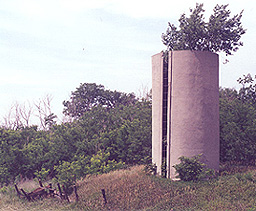 Weeping barns along swallow roads…Route 36 has its share of falling-down-in barns. I got to thinking about creating a book of photographs of these old, unkempt barns, and the stories behind them… "Stories of the Forgotten." But where would one stop? And after a dozen barns or so, it might become too depressing.
Weeping barns along swallow roads…Route 36 has its share of falling-down-in barns. I got to thinking about creating a book of photographs of these old, unkempt barns, and the stories behind them… "Stories of the Forgotten." But where would one stop? And after a dozen barns or so, it might become too depressing.
The last day crossing Kansas in the northern part, hot hot, thank heavens for the car's air conditioning, the landscape still beautiful but drying, drying, the rainfall shrinking from the east border to the west. Always climbing subtly, heaving a little higher and opening to a broader sweep to distance horizons. Suddenly 30 miles are in sight.
I think of the buffalo commons, a concept thought of by two folks (Rutgers College professors) as they traveled these roads. For this is the very land that shook under the feet of millions of buffalo, and now shakes under the huge (and I mean huge) rigs that plant, cultivate, spray, and harvest the wheat, the soybeans, and the corn in this water-hungry land. There is nothing more torturous, in my eyes, than to see the long, sweeping irrigator rigs that water the corn, draining water from the Ogallala Aquifer, a huge underground source which is not being replenished at anywhere near the rate that it is being drawn down.
And for what? For crops that farmers are losing money to grow. I wonder, as I drive along, how can one remodel the plains economy and yet not lose the small-town, home-grown culture that these farming communities embody. I don't know, but Ted Turner is working one angle by buying huge ranches in the plains states and converting them to buffalo spreads. But it will take a major paradigm shift (there, I've finally used this word that I didn't know how to pronounce two years ago, much less its meaning) to bring it into the local culture and make it desirable. For nothing will change if the farmers on the ground find nothing "bettering" about such a shift. Unless the Aquifer gets drained too much, and cropping becomes moot.
At last into Colorado, where I watch a mass of clouds building in the west, with rain curtains drifting down. Eventually I find myself sweeping between two massive gray pillars of rain, lightning-streaked, one hanging a little north of the highway, the other directly south. I receive a brief splattering before I am west of it and running the final lonely stretch of highway before getting onto I-70 a little east of Denver.
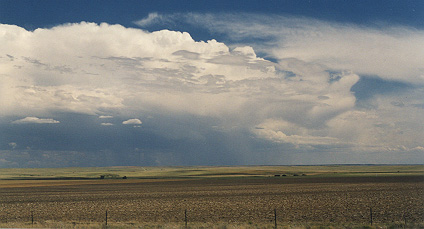
I am saturated with landscape.
And it is beautiful.
Cherie
Photos: (1)Nebraska hayfield; (2) East Montpelier, Center Road view; (3)Our sandcastle and hobbit-hole (with visitor); (4) the gulls on Short Sands; (5) tree-filled silo in Kansas; and (6) Colorado plains perspective, looking east.
(Copyright 2000 by Cherie Staples - No reproduction without express permission from the author)
Table of Contents
Letter to the Author: Cherie Staples at skyearth1@aol.com
 Onto I-80 and into Nebraska and fields laden with hay: huge loaves artfully stacked; big round bales gleaming from the late sun shining on their green plastic wrappings. My first experience of $2/gallon gas, thankful for my 30-miles-to-the-gallon Subaru. Slept in York, about a hundred miles from the Iowa border.
Onto I-80 and into Nebraska and fields laden with hay: huge loaves artfully stacked; big round bales gleaming from the late sun shining on their green plastic wrappings. My first experience of $2/gallon gas, thankful for my 30-miles-to-the-gallon Subaru. Slept in York, about a hundred miles from the Iowa border.
 June 14th: Lonely (and quiet) provincial highways lead me downward to I-401 running east along the St. Lawrence River, although hardly within view. I don't actually see much river until the border crossing at Ogdensburg, New York, a much smaller town than Cornwall further east. Sad and abandoned farms linger along the highway across the northern part of New York state as I head toward Massena and eventually Rouse's Point Bridge to Vermont. (I mention this to my farm friends in East Montpelier, and they comment that the soils are just too poor to be farmable.) In North Hero, I talk half the night and the next morning with a good friend whose mind bends in a similar direction as mine, sharing insights and good books.
June 14th: Lonely (and quiet) provincial highways lead me downward to I-401 running east along the St. Lawrence River, although hardly within view. I don't actually see much river until the border crossing at Ogdensburg, New York, a much smaller town than Cornwall further east. Sad and abandoned farms linger along the highway across the northern part of New York state as I head toward Massena and eventually Rouse's Point Bridge to Vermont. (I mention this to my farm friends in East Montpelier, and they comment that the soils are just too poor to be farmable.) In North Hero, I talk half the night and the next morning with a good friend whose mind bends in a similar direction as mine, sharing insights and good books.

 We walk the path through the Rachel Carson National Wildlife Refuge, and I remember the wonderful performance at the conference in May by a woman who became "Rachel" during the last three years of her life, in the aftermath of writing Silent Spring and the foreknowledge of her death from cancer. At Parsons Beach, I am entranced by the way the sun creates a glittering sheen on the just-wet sand as the waves retreat. At Short Sands, the gulls walk the wet sands and, against the dusk, float up and down the beach.
We walk the path through the Rachel Carson National Wildlife Refuge, and I remember the wonderful performance at the conference in May by a woman who became "Rachel" during the last three years of her life, in the aftermath of writing Silent Spring and the foreknowledge of her death from cancer. At Parsons Beach, I am entranced by the way the sun creates a glittering sheen on the just-wet sand as the waves retreat. At Short Sands, the gulls walk the wet sands and, against the dusk, float up and down the beach.
 Weeping barns along swallow roads…Route 36 has its share of falling-down-in barns. I got to thinking about creating a book of photographs of these old, unkempt barns, and the stories behind them… "Stories of the Forgotten." But where would one stop? And after a dozen barns or so, it might become too depressing.
Weeping barns along swallow roads…Route 36 has its share of falling-down-in barns. I got to thinking about creating a book of photographs of these old, unkempt barns, and the stories behind them… "Stories of the Forgotten." But where would one stop? And after a dozen barns or so, it might become too depressing.
